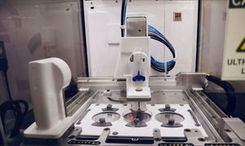MSU-led team is creating 'living' materials that sequester carbon






Microbes at work: This microscope image shows a close-up of biomaterials made by microbes. //Jinxing Li, Michigan State University
November 16, 2023
BY Michigan State University, Matt Davenport
Advertisement
Advertisement
Related Stories
Deep Sky Secures First-of-its-Kind Financing with Finalta Capital to Advance Carbon Removal in Canada
Deep Sky has secured an $11 million bespoke credit facility from Finalta Capital to finance its flagship Alpha carbon removal facility in Alberta. Alpha, the world’s first cross-technology carbon removal site, became North America’s first DAC project to sequester CO₂ underground.
Boral Successfully Trials Concrete with Recycled Concrete Aggregates Recarbonated via Carbon Capture from a Cement Plant – An Australian First
Boral has successfully trialed concrete made with recycled aggregates recarbonated via carbon capture technology from its Berrima cement plant. The pilot, supported by the federal CCUS Development Fund, replaced 50% of natural coarse aggregates with recarbonated recycled materials in a low-carbon mix.
Capsol Technologies has been awarded a feasibility study for a European Bioenergy with Carbon Capture and Storage (BECCS) project. The biomass-fired combined heat-and-power plant under evaluation could remove more than 200,000 tonnes of CO₂ annually while supplying renewable heat to local communities.
Chemists at the University of Copenhagen have developed a method to transform PET plastic waste into a powerful new material for CO₂ capture. The material, called BAETA, can absorb carbon emissions efficiently and be regenerated for reuse, offering a scalable, low-energy alternative to existing capture technologies.
A University of Houston team led by Professor Mim Rahimi has developed a membraneless electrochemical amine regeneration process that achieves over 90% CO₂ removal at roughly $70 per ton, significantly reducing both costs and energy use.





